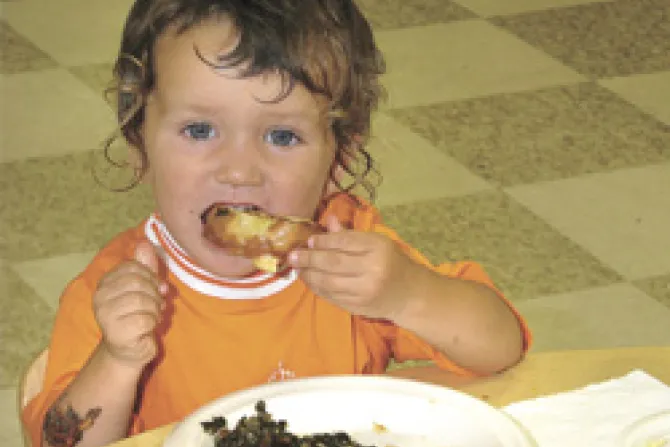New Orleans, La., Jul 11, 2010 / 13:14 pm
Second Harvest Food Bank is filling a need that sometimes gets overlooked during the summer: ensuring that New Orleans children have nutritional food at least during the week.
Tony Biggs, director of culinary operations at Second Harvest, has helped develop an eight-week Summer Feeding program whereby breakfast and lunch are served to low-income children.
Leslie Doles, director of communications and public relations for Second Harvest, an affiliated corporation of Catholic Charities, said there is a real need for this program.
“Federally funded breakfast and lunch programs are important,” Doles said. “When schools are out for the summer, some kids don’t know when they will have their next meal because they lose their two meals a day through the free or reduced-price lunch programs at school. We are that safety net, filling that need they are not getting.”
Doles considers Summer Feeding a natural continuation of Second Harvest’s school year backpack program that sends food home with children on Fridays to ensure they have weekend food. She said only 13 percent of children receiving free and reduced lunch in Second Harvest’s service area have access to a summer feeding program.
Biggs, 53, who has a background in restaurant, resort hotel and casino food management, had to learn federal nutritional guidelines and food portioning before he started the program June 7.
4,000 meals a week
He’s currently providing approximately 4,000 meals a week – using a four-week menu plan – to children at five summer camp sites through July 30. The food is prepared at a central kitchen at Grace Episcopal Church.
Biggs said he avoided chicken nuggets and hot dogs and opted for more nutritional food. Lunch variety includes sweet and sour chicken with salad, fruit and milk; macaroni and cheese with collard greens, salad, fruit and chocolate pudding; spaghetti and meat sauce with carrots and fruit; beef tacos with refried beans, salad and fruit. Milk is a requirement at breakfast and lunch.
He was able to supplement the menu with more fresh fruit due to a generous, start-up grant from the Emeril Lagasse Foundation.
“We’re giving a little extra with the money from Emeril Lagasse,” he said. “These kids won’t go away hungry. ... Our goal is to fill kids up.”
Betty Zachary, junior warden of Grace Episcopal, is thrilled with the quality of the food offered to her campers.
“Second Harvest took care of us,” she said, adding how Biggs tailored a vegetarian menu for her campers.
Summer Feeding is a pilot program – based on successful food bank programs in San Antonio, Texas, and Savannah, Ga. – to test the waters for expansion to other area centers and nonprofits.
Part of strategic plan
Offering Summer Feeding is just one aspect of Second Harvest’s long-range, strategic planning that began in 2007. The most important piece was moving – in April 2010 – to a 200,000-square-foot warehouse with dry and cold storage space on Edwards Avenue in Harahan. The former warehouse had only 29,000 square feet.
(Story continues below)
“We can now accept food that we could never accept before,” Doles said, such as fresh fruit, produce and more meat. More space also provides the ability to schedule more volunteers simultaneously to help process food donations and to provide additional nutrition assistance for seniors on fixed incomes and low-cost meals to feeding lines and member agencies.
“This will allow us to increase the number of meals we provide,” Doles said. “It will advance our mission to serve seniors and children.”
Goal: A permanent kitchen
Another part of the plan is adding a permanent, community kitchen with an initial goal of producing 100,000 prepared meals a month. A $1 million gift from Catholic Charities USA after Hurricane Katrina will jump start the projected $2 million project, Doles said.
Plans for this kitchen, being designed by Biggs, will be unveiled in August.
“The community kitchen can help us minimize the possibility of waste,” Doles said. “Fresh items can be prepared into meals. ... Our hope is to have a working kitchen in our warehouse by next summer.”
Pre-Katrina, Second Harvest distributed 14.5 million pounds of food. Over the past 12 months, Doles said 19 million meals were distributed. By 2013, she predicts that 38 million meals will be needed annually.
To meet the growing need for food, Second Harvest began partnering with local grocers with retail store pick-up. Second Harvest “rescues” food that is still good but taken off the shelves.
More cooler/freezer space, and a new cook/chill machine will be incorporated in the new kitchen. This will position Second Harvest to cook and freeze large volumes of food for quick distribution in cases of emergency such as a hurricane or the recent oil spill.
“Disaster response is a big part of our ministry whether it’s oil spill or hurricane related,” Doles said.
Other advantages of the larger warehouse: creating revenue sources for Second Harvest. Part of the new warehouse is being rented, but plans are to build a second show kitchen to be utilized by the community.
“We’ve come a long way since Katrina in terms of taking care of the community,” Doles said. “The community kitchen is an important element to help achieve future goals.”
Printed with permission from the Clarion Herald, newspaper of the Archdiocese of New Orleans.


